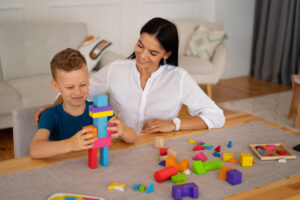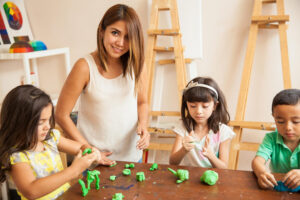Children are naturally curious for different shapes and colours. They explore the world by seeing, hearing, and smelling new things. They have unique ways of learning and remembering what they discover. Watching your child understand the world can be wonderful and exciting. Why not join them in making sense of all the information they need to process?
“Shapes and colours bring life to the simplest things.”
– Unknown.
Here are some simple ways to help your child learn about them:
1. Block Set
Shape building blocks are a fun and hands-on way for children to learn about shapes and geometry. Kids can use the blocks to create squares, triangles, rectangles, circles, and more. This activity encourages creativity and imagination as children combine blocks to build more complex structures. It also promotes collaborative play, allowing kids to work together to create larger shapes or imaginative scenes with their blocks.
2. Use colorful toys
Children love playing with toys. Ask them to point to the red car, the green robot, the pink doll, or the black bike. If they get it wrong, show them something with the same color and ask if that’s what they meant. This helps them learn the correct colors.
3. Clay Creations
Playing with clay is a fun way for young children to use their imagination and creativity. Toddlers, preschoolers, and kindergarten kids can make different shapes and objects with moldable clay. They can start with simple geometric forms and move on to more complex designs like animals, buildings, and imaginary creatures. This activity helps them develop their artistic skills and cognitive abilities.
4. Different Colored Balloons
Colorful balloon toss is an enjoyable game for children. Start by inflating balloons in various bright colors and scattering them around the play area. Place matching color buckets or containers in different spots. The goal is for children to toss the balloons into the matching color buckets, aiming for accuracy. This game not only adds fun to learning but also provides a great opportunity for physical exercise and outdoor play.
5. Show examples of different shapes and colours from nature
If you are indoors, take your child to the balcony and show them how the sky changes colors throughout the day. Lightheartedly highlight how the colors of surrounding buildings, roads, and other objects become lighter during the day and darker after sunset. This helps children learn about color depth.
6. A Plateful of Color
Serve your children nutritious meals which are colorful. Decorate a sandwich with olives for black eyes, a triangular piece of cheese for a cream-colored nose, and a tomato slice for a mouth. Include healthy, raw vegetables in their daily meals and teach them the names and colors of veggies and fruits. For example, say “orange carrot” instead of just “carrot” and “green cucumber” instead of just “cucumber”
7. Trace objects to learn shapes
Place 3D objects on a blank sheet of paper and ask children to trace their outlines with a pencil. Start with simple items like coffee mugs and pencil boxes. This helps children learn to capture 3D objects on a 2D surface and quickly notice differences in shapes and colours.
8. Find simple shapes and colours in nature
Ask your children questions about shapes in the world around them. For example, “What is the shape of a building?” or “What shape is this food item?” This aids them in quickly recognizing shapes by using natural examples.
9. Compare shapes and colours of different objects
Test your child’s understanding of shapes by asking them to fetch items by shape, like the “square” fruit or the “circular” pencil. You’ll know they understand if they correct you or laugh at your “silly” request.
10. Identify and Seek
Play a fun game with your child by giving them commands to find objects based on colors and shapes. Start with simple instructions like “Get me something green” or “Fetch something round.” As the game progresses, make it more challenging by combining instructions, such as “Get me something red and round,” and enjoy watching your child search for a tomato in the fridge.
11. Make Labels
Add shape labels to common objects at home. Instead of writing the shape name, use labels with shape icons, like a rectangle on a door, a circle on a ball, and a square on a window. This helps your toddler make connections and understand shapes better.
Final Thoughts
Understanding shapes helps toddlers make sense of the world since shapes are the building blocks of the objects they see every day. Learning colors improve their visual perception and communication skills. By sharing their discoveries and playing together, toddlers develop important social and communication skills.
Shape and color activities are essential for a child’s overall development, making learning fun and fostering a lifelong love for exploration and discovery. These activities are a key part of early childhood education, helping toddlers navigate their world with confidence and curiosity.


Add Comment